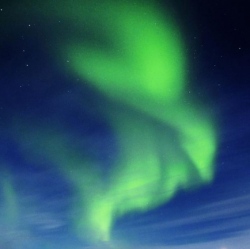
Astronomers have discovered the first auroras ever seen outside the solar system, alien light shows more powerful than any other auroras ever witnessed, perhaps 1 million times brighter than any on Earth. Auroras could soon be detected from distant exoplanets as well, investigators added.
Auroras, the radiant displays of colors in the sky known on Earth as the northern or southern lights, are also seen on all of the other planets with magnetic fields in the solar system. They are caused by currents in the magnetosphere of a planet, the shell of electrically charged particles captured by a planet’s magnetic field, that force electrons to rain down on the atmosphere, colliding with the molecules within and making them give off light.
To see if auroras might be seen outside the solar system, astronomers investigated a mysterious Jupiter-size object called LSR J1835+3259, located about 18.5 light-years from Earth. The object is a few dozen times more massive than Jupiter, suggesting it is too heavy to be a planet but too light to be a star, the researchers said.
They suggested that LSR J1835+3259 is a brown dwarf, a strange misfit object sometimes known as a failed star. As massive as brown dwarfs are compared to planets, they are too puny to force atoms to fuse together and release the nuclear energy that powers stars.
In 2001, scientists unexpectedly discovered that brown dwarfs could generate radio waves. "That was very surprising," said Gregg Hallinan, an astronomer at the California Institute of Technology in Pasadena and leadauthor of the new study. "Typically, we see radio waves from really active stars, not objects with much cooler temperatures like brown dwarfs," he told Space.com.
Until now, the brightest known auroras came from Jupiter, which has the most powerful magnetic field in the solar system. In comparison, these newfound auroras are more than 10,000 times, and maybe 100,000 times, brighter than Jupiter’s, Hallinan said. This is because LSR J1835+3259 has a magnetic field perhaps 200 times stronger than Jupiter’s, he said.
It remains a mystery what might drive LSR J1835+3259’s auroras. On Earth, auroras are driven by winds of electrically charged particles streaming from the sun, but this brown dwarf does not have a stellar companion.
One possibility is that LSR J1835+3259’s auroras are driven by an Earth-size planet that generates strong currents in the brown dwarf’s magnetosphere as it barrels through its magnetic field, Hallinan said. Auroras on Jupiter are driven, in part, by its moon Io plowing through Jupiter’s magnetic field.
